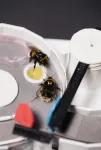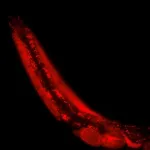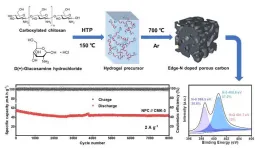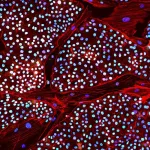(Press-News.org) In a groundbreaking discovery, bumblebees have been shown to possess a previously unseen level of cognitive sophistication. A new study, published in Nature, reveals that these fuzzy pollinators can learn complex, multi-step tasks through social interaction, even if they cannot figure them out on their own. This challenges the long-held belief that such advanced social learning is unique to humans, and even hints at the presence of key elements of cumulative culture in these insects.
Led by Dr Alice Bridges and Professor Lars Chittka , the research team designed a two-step puzzle box requiring bumblebees to perform two distinct actions in sequence to access a sweet reward at the end. Training bees to do this was no easy task, and bees had to be helped along by the addition of an extra reward along the way. This temporary reward was eventually taken away, and bees subsequently had to open the whole box before getting their treat. Surprisingly, while individual bees struggled to solve the puzzle when starting from scratch, those allowed to observe a trained "demonstrator" bee readily learned the entire sequence – even the first step – while only getting a reward at the end.
This study demonstrates that bumblebees possess a level of social learning previously thought to be exclusive to humans. They can share and acquire behaviours that are beyond their individual cognitive capabilities: an ability thought to underpin the expansive, complex nature of human culture, and one previously thought to be exclusive to us.
Dr Bridges emphasises the novelty of this finding: "This is an extremely difficult task for bees. They had to learn two steps to get the reward, with the first behaviour in the sequence being unrewarded. We initially needed to train demonstrator bees with a temporary reward included there, highlighting the complexity. Yet, other bees learned the whole sequence from social observation of these trained bees, even without ever experiencing the first step's reward. But when we let other bees attempt to open the box without a trained bee to demonstrate the solution, they didn’t manage to open any at all."
Beyond individual learning, this research opens exciting possibilities for understanding the emergence of cumulative culture in the animal kingdom. Cumulative culture refers to the gradual accumulation of knowledge and skills over generations, allowing for increasingly complex behaviours to develop. The bees' ability to learn such a complex task from a demonstrator suggests a potential pathway for cultural transmission and innovation beyond their individual learning capabilities.
Professor Chittka further underscores the implications: "This challenges the traditional view that only humans can socially learn complex behaviour beyond individual learning. It raises the fascinating possibility that many of the most remarkable accomplishments of the social insects, like the nesting architectures of bees and wasps or the agricultural habits of aphid- and fungus-farming ants, may have initially spread by copying of clever innovators, before they eventually became part of the species-specific behaviour repertoires."
This groundbreaking research opens new avenues for understanding animal intelligence and the evolution of social learning. It challenges longstanding assumptions and paves the way for further exploration of the cognitive wonders hidden within the insect world, even hinting at the exciting possibility of cumulative culture amongst seemingly simple creatures.
END
Bee-2-Bee influencing: Bees master complex tasks through social interaction
Bumblebees surprise scientists with advanced social learning skills
2024-03-06
ELSE PRESS RELEASES FROM THIS DATE:
New study may broaden the picture of the consequences of childhood adversity
2024-03-06
A research team has examined the link between adverse childhood experiences and the risk of mental health problems later in life, according to a study in JAMA Psychiatry. The researchers from Karolinska Institutet and University of Iceland have found that the risk of suffering from mental illness later in life among those experiencing significant adversity in childhood can be partly explained by factors shared by family members, such as genetics and environment.
Several previous studies have shown that people who have experienced ...
Revealing the evolutionary origin of genomic imprinting
2024-03-06
Some of our genes can be expressed or silenced depending on whether we inherited them from our mother or our father. The mechanism behind this phenomenon, known as genomic imprinting, is determined by DNA modifications during egg and sperm production. The Burga Lab at the Institute of Molecular Biotechnology (IMBA) of the Austrian Academy of Sciences uncovered a novel gene regulation process, associated with the silencing of selfish genes, that could represent the first step in the evolution of imprinting. Their discovery, reported in Nature, ...
Universal tool for tracking cell-to-cell interactions
2024-03-06
One of the fundamental goals of basic biology is understanding how diverse cell types work in concert to form tissues, organs, and organ systems. Recent efforts to catalog the different cell types in every tissue in our bodies are a step in the right direction, but only one piece of the puzzle. The great mystery of how those cells communicate with one another remains unsolved.
Now, a new paper in Nature describes uLIPSTIC, a tool capable of laying the groundwork for a dynamic map tracking the physical interactions between different cells—the elusive cellular interactome. The authors have been perfecting the technology since 2018 and the latest iteration ...
Synthetic DNA sheds light on mysterious difference between living cells at different points in evolution
2024-03-06
“Random DNA” is naturally active in the one-celled fungi yeast, while such DNA is turned off as its natural state in mammalian cells, despite their having a common ancestor a billion years ago and the same basic molecular machinery, a new study finds.
The new finding revolves around the process by which DNA genetic instructions are converted first into a related material called RNA and then into proteins that make up the body’s structures and signals. In yeast, mice, and humans, the first step in a gene’s expression, transcription, proceeds as DNA molecular “letters” (nucleobases) are read in one direction. While 80% of the human genome ...
AI can speed design of health software
2024-03-06
Artificial intelligence helped clinicians to accelerate the design of diabetes prevention software, a new study finds.
Publishing online March 6 in the Journal of Medical Internet Research, the study examined the capabilities of a form of artificial intelligence (AI) called generative AI or GenAI, which predicts likely options for the next word in any sentence based on how billions of people used words in context on the internet. A side effect of this next-word prediction is that the generative AI “chatbots” like chatGPT can generate replies to questions in realistic language, and produce clear summaries of complex texts.
Led ...
Shrinking technology, expanding horizons
2024-03-06
The National Institute of Standards and Technology (NIST) and its collaborators have delivered a small but mighty advancement in timing technology: compact chips that seamlessly convert light into microwaves. This chip could improve GPS, the quality of phone and internet connections, the accuracy of radar and sensing systems, and other technologies that rely on high-precision timing and communication.
This technology reduces something known as timing jitter, which is small, random changes in the timing of microwave signals. Similar to when a musician is trying to keep a steady beat in music, the timing of these signals can sometimes waver a bit. The researchers ...
Edge-nitrogen doped porous carbon for energy-storage potassium-ion hybrid capacitors
2024-03-06
They published their work on March. 4th in Energy Material Advances, a Science Partner Journal (https://spj.science.org/journal/energymatadv).
"The development of cost-effective and high-performance electrochemical energy storage devices is imperative," said paper's corresponding author Wei Chen, a professor in the School of Chemistry and Materials Science, University of Science and Technology of China (USTC). "Currently, lithium-ion batteries still dominate the market, but they are limited in both lithium as a resource and in their power densities."
Chen ...
Revolutionary elephant iPSC milestone reached in Colossal’s Woolly Mammoth Project
2024-03-06
Dallas, TX – March 06, 2024 - Colossal Biosciences (“Colossal”), the world’s first de-extinction company, announces today that their Woolly Mammoth team has achieved a global-first iPSC (induced pluripotent stem cells) breakthrough. This milestone advancement was one of the primary early goals of the mammoth project, and supports the feasibility of future multiplex ex utero mammoth gestation.
iPSC cells represent a single cell source that can propagate indefinitely and give rise to every other type of cell in a body. As such, the progress with elephant iPSCs extends far beyond ...
JAMA study finds facilities treating poor patients penalized by CMS payment model
2024-03-06
INDIANAPOLIS – A new study of more than 2,000 dialysis facilities randomized to a new Medicare payment model aimed to improve outcomes for patients with end-stage kidney disease has found that facilities that disproportionately serve populations with high social risk have lower use of home dialysis and transplant waitlisting and fewer kidney transplants. These facilities thus received reduced performance scores and reimbursement from Medicare.
A high proportion of non-Hispanic Blacks and of those initiating dialysis while uninsured or Medicaid-covered also was found to be an indicator of lower use of home dialysis and transplant waitlisting and fewer kidney ...
For Boston College professor, research into "high latitude" reaches of the seas led to improving accurate access to real-time ocean data
2024-03-06
Chestnut Hill, Mass (03/06/2024) – Boston College Assistant Professor of Earth and Environmental Sciences Hilary Palevsky has been awarded a nearly $1-million National Science Foundation CAREER Award for her work to make remote ocean monitoring data accessible and accurate in real time and produce a series of educational videos to guide students using the data.
Palevsky, whose research focuses on marine biogeochemistry and the mechanisms that enable the ocean to absorb carbon dioxide from the atmosphere, said the funding will allow her to build upon the work she has done to help scientists use the ...
LAST 30 PRESS RELEASES:
The perfect plastic? Plant-based, fully saltwater degradable, zero microplastics
Bias in data may be blocking AI’s potential to combat antibiotic resistance
Article-level metrics would provide more recognition to most researchers than journal-level metrics
Satiety’s little helper: Protein that supports appetite regulating protein identified
UF dives deep into predicting storm damage with computer models
A stormy ocean voyage yields insights on the global carbon cycle
Scientists identify first non-coding gene that controls cell size
Demonstration of altermagnetism in RuO₂ thin films -- A new magnetic material for the AI era
Penn researchers awarded $25M to conduct trial using smartphones to fight heart disease
PCORI awards funding for new patient-centered healthcare research
Exploring the origins of the universe: 145 low-noise amplifiers complete ALMA telescopes
Empress cicada wings help illuminate molecular structure
Using sound waves to detect helium
Time burden in patients with metastatic breast and ovarian cancer from clinic and home demands
Researchers discover bias in AI models that analyze pathology samples
Scientists ID potential way to prevent brain injuries from triggering Alzheimer's
MASTER 2nd Open Call: Execution period kick-off
Algae for health in food and pharma
Advanced microrobots driven by acoustic and magnetic fields for biomedical applications
Chicago health information leader recognized for raising CPR readiness and blood pressure awareness
The Intimate Animal, a new book from Kinsey Institute Executive Director Dr. Justin Garcia
When blue-collar workers lose union protection, they try self-employment
New video dataset to advance AI for health care
MEA-based graph deviation network for early autism syndrome signatures in human forebrain organoids
New modeling approach sheds light on rare gut disease
Study documents potentially hazardous flame retardants in firefighter gear
Can certain bacteria regulate aging of the immune system and its related alterations?
AI model helps diagnose often undetected heart disease from simple EKG
There are fewer online trolls than people think
Cell membrane fluctuations produce electricity
[Press-News.org] Bee-2-Bee influencing: Bees master complex tasks through social interactionBumblebees surprise scientists with advanced social learning skills





